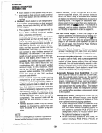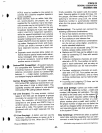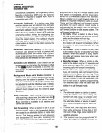
STRATA DK
GENERAL DESCRIPTION
DECEMBER 1990
assignment may be assigned to the system for
zach DAY, DAY2 or NIGHT mode (see
DAY/NIGHT Modes). If a station is pro-
grammed to ring for a particular CO line, then
a choice may be made between three timing
specifications:
l
Immediate: Stations assigned IMMEDI-
ATE timing ring as soon as the CO line
rings into the system.
l
Delay 1: If stations with IMMEDIATE tim-
ing have not answered within 12 seconds
(three rings), stations assigned DELAY 1
timing begin ringing also.
l
Delay 2: If the above stations have not
answered within 24 seconds (6 rings), sta-
tions assigned DELAY 2 timing begin ring-
ing also.
Flexible Port/Line Assignment: The system’s
universal slots can be assigned to station, CO
line, or E & M TIE line PCBs in a variety of
custom configurations. See System Capacity
and Configuration.
Group Paging*: Dialing a 2-digit access code
permits a user to make vocal announcements
to one of four internal station groups or all sta-
tions simultaneously. Any station receiving an
announcement can directly access the origina-
tor by dialing a code, although any other sta-
tion receiving the announcement will be cut
off. Stations are assigned to groups when the
system is programmed. This feature is inde-
pendent of external paging zones, which reach
external speakers (see External Zone Paging).
Least Cost Routing*: Eight different routing
plans may be designed to automatically place
outgoing calls using the most cost-efficient
method. Three different LCR time schedules
can be set up for the business day. Each
schedule can use a different priority sequence
to place calls, depending on the time of day.
Stations can be grouped into one of four class-
es of LCR. Each class has its own routing pri-
ority. Selected station users may have priority
use of a line, even when the route with the
lowest cost is not available. LCR is compatible
with ABR and two CO line conference.
*Available using standard or electronic telephones.
Live System Programming: Programming the
system does not normally interrupt service.
When the system is>rogrammed on-site, only
the station executing commands loses normal
function. When the system is programmed
from a remote terminal, all stations remain
functional. Service is only interrupted for hard-
ware upgrades.
Memory Protection: If the power fails, the sys-
tem has an internal battery backup that pro-
tects data and the customer’s programmed
configuration. This information will be main-
tained within a powerless system for approxi-
mately six years.
Message Waiting: Any station and most voice
mail devices can leave a message waiting
indication at a digital or an electronic station
which causes the called digital station’s MES-
SAGE LED or called electronic station’s
MW/FL LED to flash. In such a case, the sta-
tion user can either automatically recall the
originating station or voice mail device, or can-
cel the indication without responding. Up to
three indications sent by other stations will be
queued. A fourth indication is always reserved
for the Message Center.
l
The system message waiting feature inte-
grates with most voice mail/auto attendant
devices by providing special codes that
allow the device to set and cancel the
message waiting LEDs on the digital and
electronic telephones. The digital and elec-
tronic teleohones automatically retrieve the
message ‘via the m-and m
buttons respectively.
Music-on-Hold*: A customer-supplied music
source, such as a radio or tape player, can be
connected to the system. CO lines or stations
placed on hold connect to the music-on-hold
source, and the holding party hears music.
l
The music source can be connected
directly to the controller PCB (PCTU or
PCTUS). An optional interface PCB is not
required to support this feature. However,
if the system is to be-configured with a
tape recorder that plays a pre-recorded
-34-


















